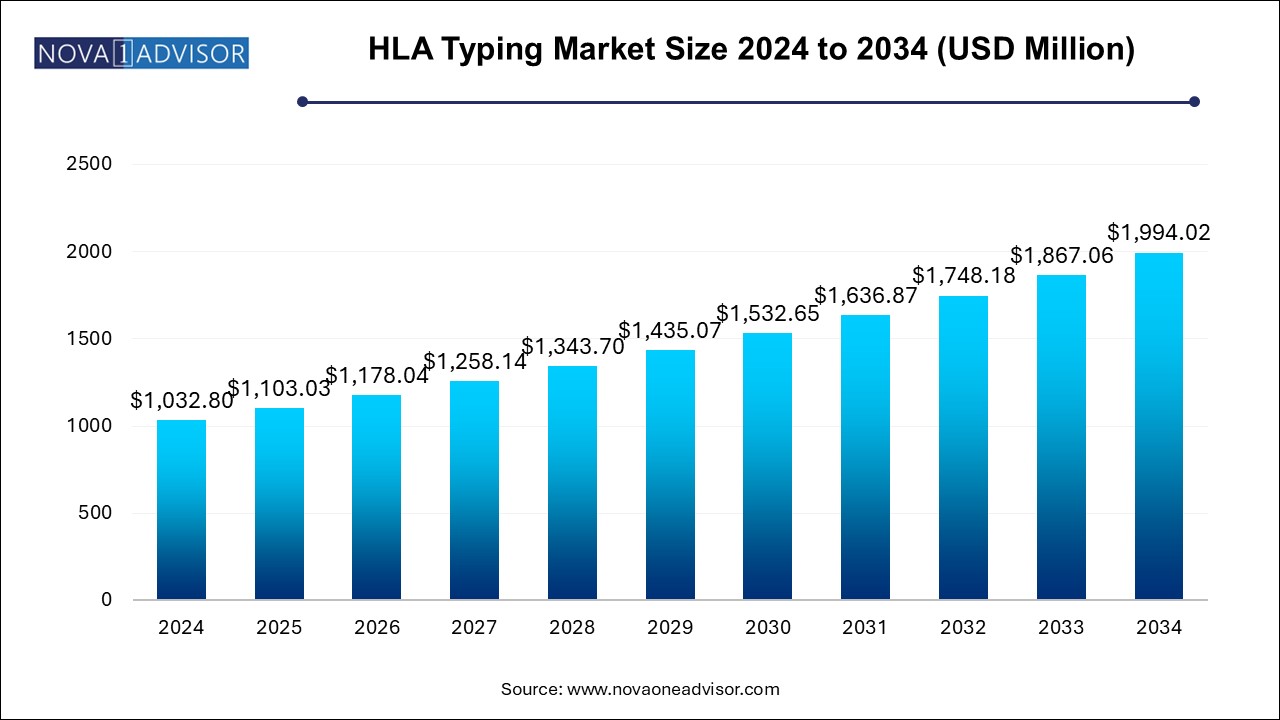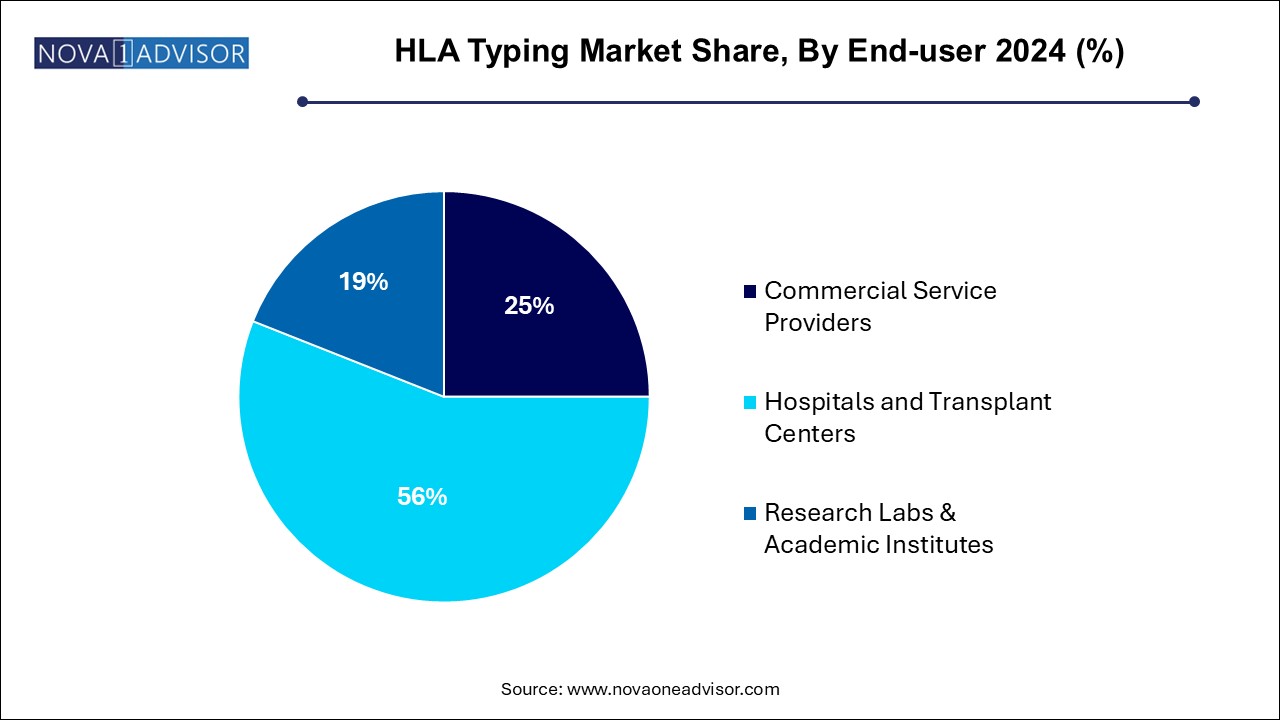HLA Typing Market Size and Research
The HLA typing market size was exhibited at USD 1,032.80 million in 2024 and is projected to hit around USD 1,994.02 million by 2034, growing at a CAGR of 6.8% during the forecast period 2024 to 2034.

HLA Typing Market Key Takeaways:
- The reagents and consumables in human leukocyte antigen typing is considered to be revenue generating segment with the largest market share of 54.2% in 2024 and fastest growth rate between 2024 to 2034.
- The diagnosis is anticipated to be the fastest-growing segment of HLA typing with a 6.8% CAGR during the forecast period.
- The molecular assay segment dominated the market and accounted for the largest revenue share of 53.0% in 2024.
- The hospitals and transplant centers segment dominated the market and accounted for the largest revenue share of 56.0% in 2024.
- North America is observed to have dominance in the HLA typing market with a share of 46.94% in 2024.
Market Overview
The HLA typing market occupies a critical space within transplant diagnostics, immunogenetics, and personalized medicine, offering essential technologies for determining human leukocyte antigen (HLA) compatibility between donors and recipients. HLA molecules are pivotal in immune system functioning, and matching HLA profiles significantly reduces transplant rejection risks and improves patient outcomes.
HLA typing is indispensable not only in solid organ and hematopoietic stem cell transplantation but also in autoimmune disease research, pharmacogenomics, and emerging fields such as immunotherapy. The demand for accurate, high-resolution HLA typing is surging, driven by the global rise in transplant procedures, expanding bone marrow registries, and advancements in molecular diagnostic technologies.
Modern HLA typing has evolved from traditional serological assays to sophisticated molecular techniques such as PCR, sequence-specific oligonucleotide (SSO) typing, sequence-based typing (SBT), and next-generation sequencing (NGS). These innovations enable high-throughput, ultra-precise typing essential for improving transplant success rates, especially with unrelated donors.
As the global focus intensifies on precision medicine, personalized treatment planning, and advanced immunotherapy development, the HLA typing market is poised for robust growth across both clinical and research applications.
Major Trends in the Market
-
Shift from Serological to Molecular HLA Typing: Molecular assays are now preferred for their superior resolution and accuracy.
-
Growing Adoption of Next-Generation Sequencing (NGS): High-throughput, multi-locus typing is gaining popularity in both clinical and research settings.
-
Integration of Artificial Intelligence (AI) in HLA Analysis: Automating complex HLA data interpretation for faster and more accurate results.
-
Expansion of Bone Marrow and Stem Cell Registries: Boosting the demand for high-resolution donor typing globally.
-
Increasing Focus on Personalized Immunotherapy: HLA typing becoming crucial in cancer vaccine development and adoptive T-cell therapies.
-
Development of Automated, Workflow-integrated HLA Typing Systems: Reducing manual error and enhancing laboratory throughput.
-
Emergence of HLA Typing for Disease Susceptibility Studies: Including autoimmune diseases, infectious diseases, and drug hypersensitivity research.
-
Geographical Expansion of Testing Facilities: Especially in Asia-Pacific and Latin America to support growing transplantation needs.
Report Scope of HLA Typing Market
| Report Coverage |
Details |
| Market Size in 2025 |
USD 1,103.03 Million |
| Market Size by 2034 |
USD 1,994.02 Million |
| Growth Rate From 2024 to 2034 |
CAGR of 6.8% |
| Base Year |
2024 |
| Forecast Period |
2024-2034 |
| Segments Covered |
Product, Application, Technique, End-user, Region |
| Market Analysis (Terms Used) |
Value (US$ Million/Billion) or (Volume/Units) |
| Regional Covered |
North America; Europe; Asia Pacific; Latin America; MEA |
| Key Companies Profiled |
Thermo Fisher Scientific Inc.; Bio-Rad Laboratories Inc.; Qiagen N.V.; Omixon Inc.; GenDx; Illumina Inc.; TBG Diagnostics Limited; Dickinson and Company; Takara Bio Inc.; F. Hoffman-La Roche Limited; Pacific Biosciences |
Key Market Driver: Rising Volume of Organ and Stem Cell Transplantations
The most significant driver accelerating the HLA typing market is the rising volume of organ and hematopoietic stem cell transplantations worldwide.
With the global burden of end-stage organ failure, leukemia, lymphoma, and other hematologic conditions increasing, there is a corresponding surge in transplant procedures. Successful transplantation heavily depends on HLA compatibility to minimize rejection risks and complications such as graft-versus-host disease (GVHD).
Programs such as the World Marrow Donor Association (WMDA) and regional bone marrow registries are expanding their donor databases, emphasizing the need for rapid, high-resolution HLA typing. The success of unrelated donor transplantations critically hinges on precise HLA matching, reinforcing the pivotal role of molecular HLA testing.
As transplantation becomes a more accessible treatment option globally, the demand for accurate and reliable HLA typing solutions is set to rise sharply.
Key Market Restraint: High Costs and Complexities of Advanced HLA Typing Technologies
A key restraint to market growth is the high cost and operational complexity associated with advanced HLA typing technologies, particularly sequencing-based assays.
Next-generation sequencing and high-resolution molecular assays require significant investment in instrumentation, reagents, bioinformatics infrastructure, and skilled personnel. Smaller healthcare facilities and transplant centers, particularly in low- and middle-income regions, may find it challenging to implement or sustain such capabilities.
Moreover, reimbursement structures for advanced HLA testing remain inconsistent across different healthcare systems, adding to financial barriers. Technical complexity can also extend turnaround times without sufficient automation, limiting accessibility.
To broaden market reach, efforts to lower costs, simplify workflows, and standardize procedures are necessary.
Key Market Opportunity: Integration of HLA Typing in Personalized Immunotherapy and Drug Development
A burgeoning opportunity in the market lies in the integration of HLA typing into personalized immunotherapy, cancer vaccine development, and pharmacogenomics.
Advances in immuno-oncology particularly the development of neoantigen-based cancer vaccines, adoptive T-cell therapies, and checkpoint inhibitors increasingly require precise HLA typing to predict immune responses and customize therapies.
Similarly, HLA genotyping is critical in identifying genetic predispositions to drug hypersensitivity reactions (e.g., HLA-B*57:01 for abacavir hypersensitivity in HIV treatment). Pharmaceutical companies are incorporating HLA profiling into clinical trials and drug labeling.
As precision medicine continues to expand, HLA typing will become a standard component of personalized treatment planning, opening new revenue streams beyond traditional transplant applications.
HLA Typing Market By Product Insights
Reagents and consumables dominate the product segment, accounting for the majority of market revenue. Frequent usage of PCR kits, sequencing reagents, oligonucleotide probes, and molecular assay consumables for each patient typing test ensures recurring demand.
Software and services are growing fastest, driven by the rising complexity of sequencing data analysis. Bioinformatics software solutions for automated allele assignment, mismatch identification, and report generation are becoming essential, while outsourced HLA typing services gain traction, particularly among small- and medium-sized transplant centers.
HLA Typing Market By Application Insights
Diagnosis dominates the application segment, reflecting the critical role of HLA typing in matching organ and stem cell donors with recipients, ensuring immunological compatibility, and preventing transplant rejection.
Research applications are growing fastest, propelled by expanding use of HLA genotyping in immunology, vaccine development, autoimmune disease research, and cancer immunotherapy studies. Academic institutions and pharmaceutical companies increasingly integrate HLA research into R&D pipelines.
HLA Typing Market By Technique Insights
Molecular assays dominate the technique segment, offering higher sensitivity, specificity, and reproducibility compared to non-molecular assays like serology and mixed lymphocyte culture (MLC).
Sequenced-based molecular assays are growing fastest, particularly next-generation sequencing (NGS) approaches that enable comprehensive, high-throughput typing across multiple loci. Sanger sequencing and other sequencing methods are also being refined for cost-effective and high-resolution typing, pushing adoption further.
HLA Typing Market By End-user Insights
Hospitals and transplant centers dominate the end-user segment, as they perform in-house HLA typing to support transplantation programs, manage patient lists, and reduce transplant wait times.

Commercial service providers are growing fastest, driven by increasing outsourcing of HLA typing to specialized reference laboratories offering high-throughput, fast-turnaround services at competitive pricing, particularly for institutions lacking in-house expertise.
HLA Typing Market By Regional Insights
North America holds the largest share of the HLA typing market, with the United States leading in transplant volumes, advanced healthcare infrastructure, and the adoption of cutting-edge molecular diagnostics.
The presence of major HLA typing companies, extensive bone marrow and organ donor registries, and strong government initiatives such as the National Marrow Donor Program (NMDP) contribute significantly to market dominance. Furthermore, robust research activity into immunogenetics and personalized medicine sustains high demand for advanced HLA typing technologies.
Asia-Pacific is the fastest-growing region, driven by rising chronic disease prevalence, growing healthcare investments, increasing transplant volumes, and expanding donor registries in countries like China, India, Japan, and South Korea.
Government programs promoting organ donation, partnerships with international transplant organizations, and rapid adoption of advanced molecular testing platforms are accelerating growth. As healthcare infrastructure matures and public awareness increases, Asia-Pacific is poised to become a major HLA typing market hub in the next decade.
Some of the prominent players in the HLA typing market include:
- Thermo Fisher Scientific Inc.
- Bio-Rad Laboratories Inc.
- Qiagen N.V.
- Omixon Inc.
- GenDx
- Illumina Inc.
- TBG Diagnostics Limited
- Dickinson and Company
- Takara Bio Inc.
- F. Hoffman-La Roche Limited
- Pacific Biosciences
Recent Developments
-
March 2025: Thermo Fisher Scientific launched the Ion Torrent Genexus Integrated Sequencer optimized for HLA typing, offering same-day high-resolution results.
-
February 2025: CareDx announced an expanded strategic partnership with Be The Match BioTherapies to enhance NGS-based HLA typing capabilities across global donor registries.
-
January 2025: QIAGEN unveiled its new QIAseq Targeted DNA Panels for high-resolution HLA typing, focusing on streamlined workflows and high-throughput compatibility.
-
December 2024: GenDx introduced its NGSengine 4.0 software, featuring enhanced automation and expanded HLA loci coverage for clinical laboratories.
-
November 2024: Omixon released Holotype HLA v5.0, an upgraded NGS-based HLA typing solution offering full gene coverage and faster turnaround for transplant laboratories.
Segments Covered in the Report
This report forecasts revenue growth at country levels and provides an analysis of the latest industry trends in each of the sub-segments from 2021 to 2034. For this study, Nova one advisor, Inc. has segmented the HLA typing market
By Product
- Instruments
- Reagents & Consumables
- Software & Services
By Application
By Technique
- Molecular Assay
- Sequenced-based Molecular Assay
- Non-Molecular Assay
By End-user
- Commercial Service Providers
- Hospitals and Transplant Centers
- Research Labs & Academic Institutes
By Regional
- North America
- Europe
- Asia Pacific
- Latin America
- Middle East and Africa (MEA)


